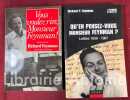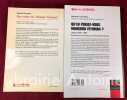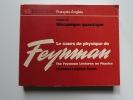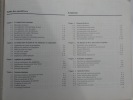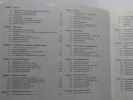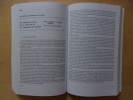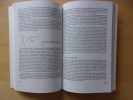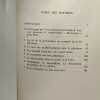25 books for « p feynman richard »Edit
-
Century
20th (15)
21st (4)
-
Topics
English (1)
History (1)
Literature (1)
Physics (13)
Sciences (4)
Sciences & technique (2)
-
Countries
Belgium (1)
Denmark (2)
France (20)
Switzerland (2)
-
Syndicate
ILAB (11)
SLAM (9)
Space-time approach to quantum electrodynamics. (+)The Theory of Positrons. - [THE BIRTH OF QUANTUM ELECTRODYNAMICS]
Lancaster, American Physical Society, 1949. Royal8vo. In contemporary full red cloth with gilt lettering to spine. In ""The Physical Review"", Second Series, Volume 76, Number 6, No. 76. Entire issue offered. From the library of Dean E. Wooldridge. His name in gilt lettering to lower part of spine. Very fine and clean. Pp. 749-760"" 769-789.
First appearance of Feyman's landmark Quantum Electrodynamics (QED) illustrated but his famous Feynman-Diagrams which ""revolutionized nearly every aspect of theoretical physics"" (Kaiser, Physics and Feynman's Diagrams). The whole field of quantum electrodynamics advanced greatly because of this graphical formalism, which allowed researchers to communicate in an effective manner. Feynman, Schwinger and Tomonago shared the 1965 Nobel Prize in Physics ""for their fundamental work in quantum electrodynamics, with deep ploughing consequences for the physics of elementary particles"".""At Cornell, Feynman perfected his approach to quantum theory, melding several of his prewar insights with the more pragmatic, numbers-driven approach he had honed during the war. One of his first tasks was to publish a long article, based on his dissertation, that presented a brand-new approach to quantum mechanics. Published in 1948 under the title, 'Space-Time Approach to Non-relativistic Quantum Mechanics'"" in the journal Reviews of Modern Physics, his lengthy article focused on the 'Lagrangian' function for a particle, a particular combination of kinetic and potential energy familiar from classical mechanics. The probability that a quantum object would travel from one location, x1, at a time t1, to some other location, x2, at a later time t2, Feynman showed, could be calculated by summing over-that is, integrating-all of the possible paths through space and time that connected these two end points. The contribution of each path to the total would be weighted by its classical Lagrangian function evaluated along that path"" hence, the technique became known as path integrals. The main difference from the standard formalism lay not in outcomes, but in conceptual approach. Werner Heisenberg and Niels Bohr had argued vehemently during the 1920s that quantum mechanics spelled the end for any type of visualization of the atomic domain. Feynman countered with an intuitive approach, built around picturing the paths of particles through space and time. His greatest success [with his Feynman-diagrams] came on the heels of this path-integral approach"" (DSB).""Feynman's two papers on QED [the two present papers] were completed in April and May 1949. In the first one, 'The Theory of Positrons,' he carefully explains the meaning of his diagrams beginning with their application to the Schrödinger equation. Application to the Dirac equation yields an interpretation of the positron in which Dirac's original hole theory is no longer needed. The second paper, 'Space-Time Approach to Quantum Electrodynamics,' contains the Feynman rules and explains their usage. By these rules, computations for specific problems are simplified so much that Schwinger, much later, said: ""Like the silicon chip of more recent years, the Feynman diagram was bringing computation to the masses"""" (Brandt, Harvest of a Century).Dean Everett Wooldridge (1913 - 2006) was a prominent engineer in the aerospace industry.
Relativistic Cut-Off for Quantum Electrodynamics [In: ""The Physical Review. Volume 74, No. 10.""]. - [FEYNMAN'S VERY FIRST PAPER ON QUANTUM ELECTRODYNAMICS (QED)]
Lancaster, American Institute of Physics, 1948. Royal8vo. Royal8vo. In the original green printed wrappers. In ""The Physical Review"", Volume 74, Second Series, Number 10, November 10. With cloth back-strip. Wrappers bound 1 mm lower than book-block, otherwise a fine and clean copy. Pp. 1430-1438. [Entire volume: Pp. (1271)-1567].
First edition of Feynman's very first paper on quantum electrodynamics (QED), being one of Feynman's most important publications which pre-dates his work on Feynman diagrams by a year. Feynman, Schwinger and Tomonago shared the 1965 Nobel Prize in Physics ""for their fundamental work in quantum electrodynamics, with deep ploughing consequences for the physics of elementary particles"".
Vous voulez rire, Monsieur Feynman ! Entretiens avec Ralph Leighton. Traduction de Françoise Balibar et Claude Guthmann.Qu'en pensez-vous Monsieur Feynman ? Lettres 1939-1987
Paris Interéditions - Dunod 1985-2006 Deux volumes in-8 393 et 322 pp. brochés.
Très bon état. Ensemble réunissant les entretiens et une correspondance choisie de Richard Feynman (1918-1988), l'un des plus grands physiciens du XXème siècle, l'un des artisans du projet Manhattan, prix Nobel 1965. Une personnalité extraordinaire, charismatique, un vulgarisateur né. Libraire membre du S.L.A.M. (Syndicat national de la Librairie Ancienne et Moderne) et de la L.I.L.A. (Ligue Internationale de la Librairie Ancienne). N'hésitez pas à prendre contact par mail pour des photographies et des détails supplémentaires, pour des recherches ou des estimations de livres anciens et rares.
The Feynman Lectures On Physics - Volume I: Mainly Mechanics Radiation And Heat + Volume II: Mainly Electromagnetism And Matter + Volume III: Quantum Mechanics - 7th printing
Addison-wesley publishing company 1972 in4. 1972. Broché. 3 volume(s). The Feynman Lectures On Physics - Volume I: Mainly Mechanics Radiation And Heat + Volume II: Mainly Electromagnetism And Matter + Volume III: Quantum Mechanics
Bon état couvertures un peu défraîchies intérieurs propres
Le cours de physique de Feynman. The Feynman lectures on physics. Tome III, Mécanique quantique.
Paris, Addison-Wesley Publishing company, 1970, in-4 oblong, broché, soft, np. Edition bilingue. Bon état.
Le cours de physique de Feynman / The Feynman lectures on physics - En 3 tomes (3 volumes) - Tomes 1+2+3 - Tome 1 : mécanique - Tome 2 : électromagnétisme - Tome 3 : mécanique quantique.
Addison-Wesley Publishing Company. 1969. In-4. Broché. Bon état, Couv. convenable, Dos satisfaisant, Intérieur frais. Environ 350-400 pages pour chacun des tomes - nombreuses figures en noir et blanc dans le texte - texte sur deux colonnes - textes en français et en anglais.. . . A l'italienne. Classification Dewey : 530-Physique
textes en français et en anglais - Tome 1 : mécanique - Tome 2 : électromagnétisme - Tome 3 : mécanique quantique. Classification Dewey : 530-Physique
Feynman (Richard P.) - Françoise Balibar et Alain Laverne, eds.
Reference : 101285
(1987)
Lumière et matière - Une étrange histoire , Traduit de l'anglais par Françoise Balibar et Alain Laverne
InterEditions Malicorne sur Sarthe, 72, Pays de la Loire, France 1987 Book condition, Etat : Bon broché, sous couverture imprimée éditeur noire, illustrée d'une image en couleurs grand In-8 1 vol. - 206 pages
93 figures dans le texte en noir et blanc 1ere édition française, 1987 Contents, Chapitres : Avant-propos, préface, note des traducteurs, avertissement - Introduction - Les photons : Des particules de lumière - Les électrons et leurs interactions - Questions en suspens - Index - Richard Feynman était professeur de physique théorique au California Institute of Technology, Sorti de Princeton en 1942, il travailla pendant la guerre au laboratoire de Los Alamos, prix Albert Einstein en 1954. - il s'est vu décerner le prix Nobel de physique en 1965 avec les professeurs J.S. Schwinger et S. Tomonaga pour leurs contributions fondamentales à l'électrodynamique quantique bon exemplaire, couverture propre, intérieur frais et propre
Genius - The life and science of Richard FEYNMAN
N.Y., Pantheon books, 1992, un fort volume in 8, cartonnage éditeur, 10pp., 531pp.
EDITION ORIGINALE
Vous y comprenez quelque chose, Monsieur Feynman ?
Odile Jacob (1/2025)
LIVRE A L’ETAT DE NEUF. EXPEDIE SOUS 3 JOURS OUVRES. NUMERO DE SUIVI COMMUNIQUE AVANT ENVOI, EMBALLAGE RENFORCE. EAN:9782738106285
Vous voulez rire, Monsieur Feynman !
Odile Jacob (2/2000)
LIVRE A L’ETAT DE NEUF. EXPEDIE SOUS 3 JOURS OUVRES. NUMERO DE SUIVI COMMUNIQUE AVANT ENVOI, EMBALLAGE RENFORCE. EAN:9782738107718
Qu'en Pensez-Vous Monsieur Feynman? - Lettres 1939-1987
Paris, 2006, in-8, 322pp, broché, Très bel exemplaire! 322pp
VOUS VOULEZ RIRE, MONSIEUR FEYNMAN ! ENTRETIENS AVEC RAPLH LEIGTHON
INTEREDITIONS. 1985. In-8. Broché. Etat d'usage, Couv. partiel. décollorée, Dos satisfaisant, Intérieur frais. 393 pages. . . . Classification Dewey : 810-Littérature américaine
traduction de l'américain par Françoise Balibar et Claude Guthmann Classification Dewey : 810-Littérature américaine
Le mouvement des planètes autour du soleil
Diderot Editeur "Jardin des sciences" 1997, in-8 broché, couverture illustrée à rabats, 162 p. (très bon exemplaire ; épuisé) Très important texte d'un cours de ce brillant physicien américain (prix Nobel de physique en 1964) que l'on croyait perdu et qui explique les principes de la mécanique céleste dans un langage simple.
Lumière et matière - Une étrange histoire.
InterEditions. 1987. In-8. Broché. Etat d'usage, Coins frottés, Dos satisfaisant, Intérieur frais. 206 pages - nombreuses figures en noir et blanc dans le texte.. . . . Classification Dewey : 530-Physique
Traduit de l'américain par Françoise Balibar et Alain Laverne. Classification Dewey : 530-Physique
La nature de la physique - Collection Points sciences n°23.
Seuil. 1980. In-12. Broché. Etat d'usage, Couv. convenable, Dos satisfaisant, Papier jauni. 296 pages - quelques figures en noir et blanc dans le texte - déchirure sur les 4 premières pages (page de faux titre, page avant propos).. . . . Classification Dewey : 530-Physique
Collection Points sciences n°23 - traduit de l'américain par Hélène Isaac, Jean-Marc Lévy-Leblond et Françoise Balibar. Classification Dewey : 530-Physique
Leçons sur la physique
Odile Jacob. 2010. In-8. Broché. Bon état, Couv. convenable, Dos satisfaisant, Intérieur frais. XXII +343 pages.. . . . Classification Dewey : 530-Physique
Préface de Roger Penrose. Classification Dewey : 530-Physique
"Lumière et matière, une étrange histoire - ""Points/sciences"" n°86"
InterEditions. 1992. In-12. Broché. Bon état, Couv. convenable, Dos satisfaisant, Intérieur frais. 206 pages - quelques schémas en noir et blanc dans le texte.. . . . Classification Dewey : 500-SCIENCES DE LA NATURE ET MATHEMATIQUES
Classification Dewey : 500-SCIENCES DE LA NATURE ET MATHEMATIQUES
"La nature de la physique - ""Points/sciences"" n°23"
Seuil. 1980. In-12. Broché. Etat d'usage, Couv. légèrement pliée, Dos satisfaisant, Intérieur acceptable. 296 pages. Quelques passages surlignés au stabilo dans le texte.. . . . Classification Dewey : 530-Physique
Classification Dewey : 530-Physique
"Leçons sur la gravitation - ""Bibliothèque"""
Odile Jacob. 2007. In-8. Broché. Bon état, Couv. convenable, Dos satisfaisant, Intérieur frais. 278 pages - nombreux schémas en noir et blanc dans le texte. 2e plat légèrement plié.. . . . Classification Dewey : 530-Physique
Trad. de l'anglais (Etats-Unis) par Céline Laroche. Classification Dewey : 530-Physique
LECONS SUR LA PHYSIQUE.
ODILE JACOB. 2000. In-8. Broché. Etat d'usage, Couv. convenable, Dos satisfaisant, Intérieur frais. 347 pages illustrées de nombreuses figures et et quelques photos en noir et blanc - 1er palt illustré d'un dessin en couleurs - Nombreuses annotatins au crayon a papier sur les pages de garde et pages de titre et contre-titre - Nombreux soulignements au crayon a papier dans le texte.. . . . Classification Dewey : 530-Physique
Classification Dewey : 530-Physique
Le Cours de physique de Feynman : mécanique 2.
Ed. Dunod, 1998, 391pp. In-8. Très bon état, couverture et intérieur très propres.
Hors frais d'expédition en France métropolitaine (tarifs compétitifs). Supplément tarifaire à prévoir pour expédition UE et hors-UE : NOUS CONTACTER. Expédition du livre à réception d'un paiement par chèque ou virement. Achat ou retrait possible en magasin.
Le Cours de physique de Feynman : mécanique 1.
Ed. Dunod, 1999, 342pp. In-8. Très bon état, couverture et intérieur très propres.
Hors frais d'expédition en France métropolitaine (tarifs compétitifs). Supplément tarifaire à prévoir pour expédition UE et hors-UE : NOUS CONTACTER. Expédition du livre à réception d'un paiement par chèque ou virement. Achat ou retrait possible en magasin.
La nature des lois physiques coll Science Nouvelle
Robert Laffont 1970 in8. 1970. Broché.
Bon état cependant présence de notes au crayon à papier sur la première moitié du livre
Leçons sur la gravitation
Editions Odile Jacob, "Sciences", 2001, 14,5 x 22, 278 pages sous couverture illustrée. Traduit de l'anglais (Etats-Unis) par Céline Laroche.
 Write to the booksellers
Write to the booksellers
![Relativistic Cut-Off for Quantum Electrodynamics [In: ""The Physical Review. Volume 74, No. 10.""]. - [FEYNMAN'S VERY FIRST PAPER ON QUANTUM ...](https://static.livre-rare-book.com/pictures/LLX/54016_1_thumb.jpg)
![Relativistic Cut-Off for Quantum Electrodynamics [In: ""The Physical Review. Volume 74, No. 10.""]. - [FEYNMAN'S VERY FIRST PAPER ON QUANTUM ...](https://static.livre-rare-book.com/pictures/LLX/54016_2_thumb.jpg)
